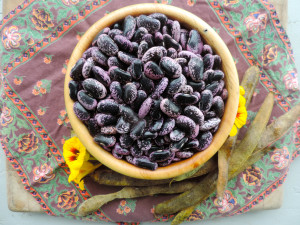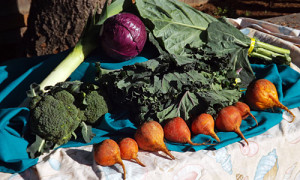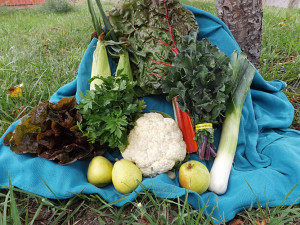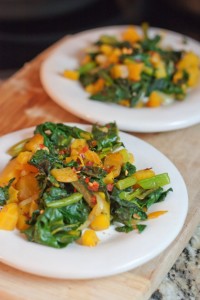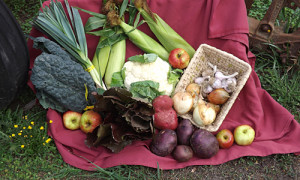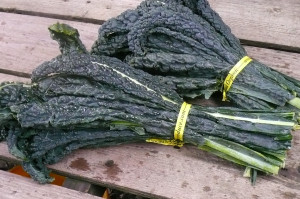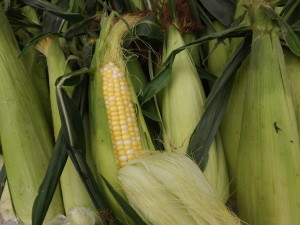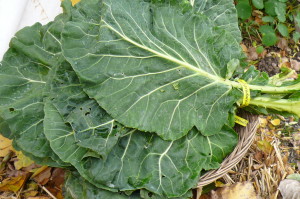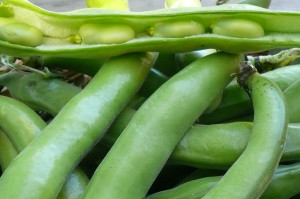Standard Box
Dried Runner Beans, 1/2 pt
Lacinato Kale, 1 bu
Bunched Carrots, 1 bu
Savoy or Red Cabbage, 1 hd
Golden Beets, 2.5 lbs
Arugula, 1 bu
Red Radishes, 1 bu
Napa Cabbage, 1 bu
Baby White Turnips, 1 bu
Potatoes, 2 lbs
Small Box
Cornmeal, med grind, 1 pt
Spinach, 1 bu
Golden Beets, 2.5 lbs
Arugula, 1 bu
Red Radishes, 1 bu
Napa Cabbage, 1 bu
Baby White Turnips, 1 bu
Savoy Cabbage
High in vitamins K and C and fiber, Savoy cabbage is also a rich source of manganese, folate, vitamin B6, potassium, and omega-3 fatty acids. Because it is so tender, don’t shy away from using it in salads. Use salt and a vinegar or lemony dressing to help it wilt a little.
Savoy cabbage is one of the sweetest of all the cabbages, and goes well with strong flavors, like sausages or seafood. It can be braised, roasted or boiled, and it’s very easy to sauté in butter, olive oil or bacon fat. It can also be used in preserved recipes like kimchi or sauerkraut.
Rocket Sauce
Rocket is another name for Arugula, a peppery-tasting leafy green, packed with nutrients and flavor! We thank Eliza Winne. a member of the Farm Store’s produce department, for this recipe.
1 bunch fresh arugula
1/4 cup olive oil
3 cloves fresh garlic
1/2 tsp. salt
Place arugula in food processor or blender. Pour in the olive oil and start the food processor. Once arugula and olive oil are thoroughly pureed, add garlic and salt. Continue blending until all ingredients are finely chopped and thoroughly mixed together.
Use fresh on salads, potatoes, pasta, sandwiches and burgers. You can also freeze some rocket sauce in ice cube trays and thaw it as needed.
The variations to this recipe are endless. Try adding greens, such as basil or parsley; blend in seeds, nuts or tahini.
Honey-Kissed Baby Turnips & Greens
4 small to medium turnips with greens
1 tsp. butter
1 tsp. olive oil
½ tsp. honey
Salt & freshly ground pepper
Wash turnip bulbs and trim tops and tails. Do not peel. Cut into half-inch slices. Wash green tops and chop.
In a heavy-bottomed skillet, melt butter and add olive oil. When butter starts bubbling, add turnips and stir to coat. Let cook over medium heat, stirring and turning periodically, until turnips begin to soften and lightly brown, about 7 minutes. Sprinkle moderately with sea salt, then add honey, stirring constantly to distribute.
Toss in the greens along with their clinging water. Continue to stir and cook until greens have wilted, about 3 minutes. Season to taste with additional salt and several grindings of black pepper. Serves two.
We thank seasonaleating.net for this recipe.
Scarlet Runner Beans
The scarlet runner beans in the Standard boxes can be cooked (soak them and cook as you would any other dried bean) and eaten, or saved and planted in the spring. The young, edible, fresh beans grow up to a foot long, and should be picked often to promote flowering. The vine should be trellised and will easily climb 10-12 feet. Sow bean seeds outside after last frost, and plant 1 inch deep and 3 inches apart. Germination takes 7-14 days during which soil should be kept moist. Thin 4-6 inches apart when plants are 2-3 inches tall. Slugs do love bean plants, so be vigilant about them, if possible. However, hummingbirds and butterflies love them, too!

